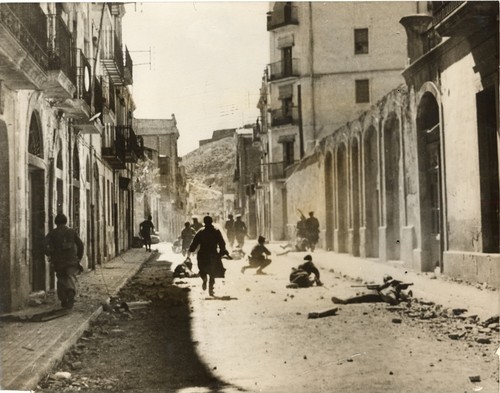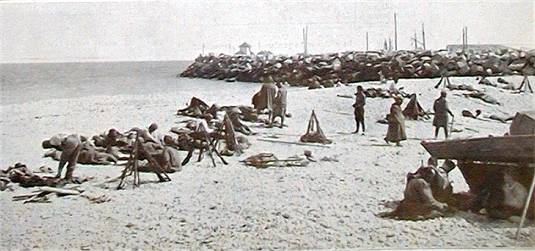*Apologies for the delays in postings. Hopefully that should be the end of the delays now*

April 1
The Nationalist troops are over the border from Aragon into Catalonia in Fraga, but they want Lleida, 28 kilometres to the northeast. First they encounter a Republican stand at Caspe, where the factions of left-wing fighters have retreated while they regroup or flee for their lives. The Nationalists easily sweep the now destroyed town of Caspe with the help of aerial support, and the Republicans continue their retreat east.
April 3
All Republican front lines have now collapsed and the International Brigade support has been destroyed. The German Condor Legion and Italian Aviazione Legionaria provide aerial support as the Nationalists storm the town of Gandesa, 50 kilometres east of Caspe. The International Brigades left decide it is time to make a stand and choose Gandesa as their town, but after two days of heavy fighting, the Nationalists managed to either bomb or shoot many of the men. Around 140 mostly British and American fighters are captured, much of them from the XV International Brigade, while the Nationalists lose no men due to their aerial attack. As the volunteers are taken prisoner, many other Republicans are given the chance to escape over the Ebro river to safety.
Meanwhile, 80 kilometres north, the Nationalists have already reached the Catalonian town of Lleida, partly with the help of the Aragon fields, which are good airstrips for the huge aerial campaign the Francoists are waging in the region. The town of Lleida has a short-lived battle, for they too are overwhelmed by Nationalists.
For the first time, the Nationalist troops can see the sea, around 50 kilometres east of Gandesa over mountainous terrain.
April 4
Today marks the first day of the Battle of Segre, which lasts for nine months along the edges of the Segre river. Both sides will each bring in 180,000 men into what will be one of the longest battles of the entire war. The Segre river runs along the border of Aragon and Catalonia, providing a fortunate front line for the Republicans, who need all the help they can get. The river helps to power the hydro dams close to the border at the Pyrenees, and provide much of the power and supplies for the city of Barcelona. The Republicans set up fortifications along the east bank of the Segre while the Nationalists set up along the west, marking the first of hundreds of skirmishes.

April 5
The small town of Balaguer, on the Catalonian side of the Segre river, suffers the first of two days of attacks by Nationalist air forces. Balaguer is only 28 kilometres north up the river from Lleida, yet Nationalist men manage to get over a bridge at Balaguer. Republicans are able to fight back and get the Nationalists back over the river. Balaguer is one of the first town to be caught up in the Segre battle.

April 8
In the far north, Franco’s men have managed to claim several hydro-electric dams. With the Talarn Dam already claimed in Lleida, these plants in the Pyrenees are vital to the survival of Barcelona. With this major coup, Franco could now easily take Barcelona and Catalonia. But Franco doesn’t want this; he wants a long drawn-out defeat of the Republicans, one that will inflict maximum suffering and death, plus a huge humiliation which will destroy any rebellion against Franco’s plans.
Franco decides he wants to continue to push through southern Catalonia and the Levante area of northern Valencia to the coast, rather than risk angering France and having them enter the battle along the Pyrenees.
April 10
The bridge over the Segre river is captured again by the Nationalists at Balaguer, allowing them access over the river to the stronghold the Republicans have set up.

April 12
The Republicans in the Balaguer area, most only teenage boys with no training, are part of the XVIII Army Corps, who counterattack along the edges of the Segre in what turns into three days of fighting that sees all of the young and keen men killed by the better organised Nationalists, who continue to establish themselves east of the river.

April 15
While things north have slowed, the Levante Offensive continued its planning as Nationalist troops under General Aranda break through and reach the coastline at Vinaròs, the most northern town in the Valencia region, rather than aiming along the Catalonian coast. While Vinaròs is a town ill-equipped and easily surrenders, it is a huge blow for the Republicans and great for Nationalist morale. The Valencian and Catalonian regions have suffered from bloody aerial attacks and internal fighting, but until now have far from the front-lines of the war. Within only four days, the Nationalist have 70 kilometres of coastline around Vinaròs.

April 19
The Aragon Offensive is finally declared over, as the region is now totally under Nationalist control. But while the Nationalists have been fighting east from Teruel to the coast, the French border has been opened for Soviet supplies to flood in, to aid the Republicans. Franco is now on the coastline and has cut off Valencia from Barcelona, but Republicans along the coast and in both regions are formidable and ready to fight back.

April 22
Another battle breaks out in Balaguer, as the Republicans fight to keep the Nationalists west of the Segre river. A week of fighting in the area sees many Republicans killed as the Nationalists finally manage to gain control over the bridge in the town. But the Republicans have not lost the area around Balaguer; they will manage to hold out for another four months, though Republican casualties will be high.
April 25
The Levante Offensive officially begins, a month after troops enter the area. The Nationalists have 125,000 troops ready to take the region with 400 aircraft, upwards of 1000 pieces of artillery and Italian support. General Varela starts to head south from Teruel in Aragon, General Aranda is in Vinaròs, and the third faction under General Valiño are in the mountainous area between these locations, all spread over a 200 kilometre area. But the terrain is difficult and wet weather means the offensive is paused after only two days. In the meantime, the Republicans in the Valencia region now have anti-aircraft guns and machine guns, fresh from the Soviet supplies, along with men who are new to fighting. It won’t be until June that these Nationalists capture any serious areas.

~~
This is not a detailed analysis, just a highlight (lowlight?) of the month’s events. Things get lost in translation – Feel free to suggest an addition/clarification/correction below. The more the world remembers, the better. All photos and captions are auto-linked to source for credit, and to provide further information.
